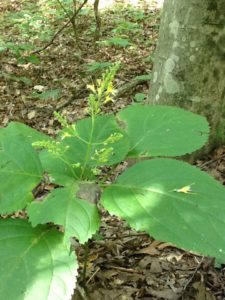By Wren Smith
Wild citronella, Collisonia canadensis has been capturing my eye on all of my recent hikes. If you have been following my blog regularly, you may know that I tend to scratch-and-sniff my way along the trail. For this reason, I have been anticipating our wild citronella coming into bloom, and today was the day! Of course I stopped and gently bruised a few of the lovely yellow blossoms. And there it was, that wonderful lemon essence I recall from many hikes in summers past.
This plant is substantial, growing 3 feet or more, and with its large oval-shaped and serrated (toothed) leaves, it is no “shrinking violet”. Yet despite its size, it often gets overlooked even when in bloom. Maybe this is because the leaves and the plants somewhat resemble the wild hydrangea, which is abundant along many woodland trails at Bernheim, or the fact that the branched flowering stalk towers above the leaves and are somewhat airy in appearance. But here’s the cool thing: once you see them, you see them. And once you take time to smell them, you will see them even more certainly, as you’ll want to give your nose this little summer treat.
Wild citronella is not the source of the oil used to repel mosquitoes, although its odor is very similar. Herbal lore points to a long history of medicinal uses for both the leaves and root of wild citronella. It was reported to be a tonic, a stimulant, and a diuretic, as well as a poultice for burns, bruises and other injuries. I make no claims of its effectiveness or safety, but I enjoy the stories almost as much as I enjoy the lemon fragrance of the flowers.
Wild citronella is a member of the mint (Laminaceae) family, which includes not only peppermint and spearmint, but also a number of garden herbs such as basil, thyme, and oregano. Members of this family have square stems and opposite leaves. In Kentucky, most plants with square stems and opposite leaves are members of the mint family, but not all. Figworts (in the genus scrophurlaria) also have square stems and opposite leaves. Just remember, all mints are square, but not all squares are mints. Wild citronella is sometimes called horsebalm or stonewort, but let me also clarify that there are several other plants that share both of these alternative common names. In fact, most plants have several common names and or share common names with other plants. This is the reason, I introduce most plants in my blog by their scientific name (genus and species). Alas, many of the scientific names are being reclassified due genetic studies and this may make your research a bit more challenging. But the rewards of knowing what you are seeing, and perhaps smelling are worth the work! The landscape becomes more companionable when you recognize and appreciate your wild plant and animal neighbors. I’m glad I got to know wild citronella, and I hope you are too.
Want more Tales from Bent Twig? Click here to view the archive.


